Emory University
Emory University is a private research university in Atlanta, Georgia.[17] Emory was founded in 1836 as "Emory College" by the Methodist Episcopal Church, and was named in honor of Methodist bishop John Emory.[18] Emory is the second-oldest private institution of higher education in Georgia and among the 50 oldest private universities in the United States.[19] Gregory L. Fenves, formerly the president of UT Austin, became Emory University’s twenty-first president in August of 2020. [20]
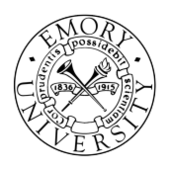 | |
Former name | Emory College (1836–1915) |
|---|---|
| Motto | Cor prudentis possidebit scientiam (Latin) |
Motto in English | The wise heart seeks knowledge[1] |
| Type | Private |
| Established | 1836[2] |
Religious affiliation | United Methodist Church[3][4] |
| Endowment | $7.87 billion (2019)[5] |
| President | Gregory L. Fenves[6] |
| Students | 15,451 (Fall 2018)[7] |
| Undergraduates | 8,079 (Fall 2018)[7] |
| Postgraduates | 7,372 (Fall 2018)[7] |
| Location | , , United States 33°47′28″N 84°19′24″W |
| Campus | Suburban 631 acres (2.55 km2) |
| Newspaper | The Emory Wheel[8] |
| Colors | Emory Blue [9] |
| Athletics | NCAA Division III – UAA[10] |
| Nickname | Eagles |
| Affiliations | |
| Website | emory |
 | |
Emory University has nine academic divisions: Emory College of Arts and Sciences, Oxford College, Goizueta Business School, Laney Graduate School, School of Law, School of Medicine, Nell Hodgson Woodruff School of Nursing, Rollins School of Public Health, and the Candler School of Theology.[21] Emory University, the Georgia Institute of Technology, and Peking University in Beijing, China jointly administer the Wallace H. Coulter Department of Biomedical Engineering.[22][23] The university operates the Confucius Institute in Atlanta in partnership with Nanjing University.[24][25] Emory has a growing faculty research partnership with the Korea Advanced Institute of Science and Technology (KAIST).[26][27][28] Emory University students come from all 50 states, the District of Columbia, five territories of the United States, and over 100 foreign countries.[29]
Emory Healthcare is the largest healthcare system in the state of Georgia[30] and comprises seven major hospitals, including the Emory University Hospital and Emory University Hospital Midtown.[31] The university operates the Winship Cancer Institute, Yerkes National Primate Research Center, and many disease and vaccine research centers.[32][33][34] Emory University is the leading coordinator of the U.S. Health Department's National Ebola Training and Education Center.[35] The university is one of four institutions involved in the NIAID's Tuberculosis Research Units Program.[36] The International Association of National Public Health Institutes is headquartered at the university[37] and the Centers for Disease Control and Prevention and the American Cancer Society are national affiliate institutions located adjacent to the campus.[38] The university is partnered with the Nobel Peace Prize-winning Carter Center.[39]
Emory University has the 17th-largest endowment among U.S. colleges and universities.[5] The university is classified among "R1: Doctoral Universities – Very high research activity"[40] and is cited for high scientific performance and citation impact in the CWTS Leiden Ranking.[41] The National Science Foundation ranked the university 36th among academic institutions in the United States for research and development (R&D) expenditures.[42][43] In 1995 Emory University was elected to the Association of American Universities, an association of the 65 leading research universities in the United States and Canada.[11]
Emory alumni include 2 Prime Ministers, 9 university presidents, 11 members of the United States Congress, 2 Nobel Peace Prize laureates, a Vice President of the United States, a United States Speaker of the House, and a United States Supreme Court Justice. Other notable alumni include Rhodes Scholars, 6 Pulitzer Prize winners, Emmy Award winners, MacArthur Fellows, CEOs of Fortune 500 companies, heads of state and other leaders in foreign government, academics, musicians, and an Olympic medalist.[44] Emory has more than 149,000 alumni, with 75 alumni clubs established worldwide in 20 countries.[45][46]
History


Nineteenth century
Emory College was founded in 1836 in Oxford, Georgia by the Methodist Episcopal Church.[49] The college was named in honor of the departed Methodist bishop John Emory.[49] Ignatius Alphonso Few was the college's first president. In 1854, the Atlanta Medical College, a forerunner of Emory University School of Medicine, was founded. On April 12, 1861, the American Civil War began. Emory College was closed in November 1861 and all of its students enlisted on the Confederate side.[49] In late 1863 the war came to Georgia and the college was used as hospital and later a headquarters for the Union Army. The university produced many officers who served in the war, including General George Thomas Anderson (1846C) who fought in nearly every major battle in the eastern theater.[50] Thirty-five Emory students lost their lives and much of the campus was destroyed during the war.[51]
Emory College, as with the entire Southeastern United States, struggled to overcome financial devastation during the Reconstruction Era. In 1880, Atticus Greene Haygood, Emory College President, delivered a speech expressing gratitude for the end of slavery in the United States, which captured the attention of George I. Seney, a New York banker. Seney gave Emory College $5,000 to repay its debts, $50,000 for construction, and $75,000 to establish a new endowment. In the 1880s, the technology department was launched by Isaac Stiles Hopkins, a polymath professor at Emory College. Hopkins became the first president of the Georgia Institute of Technology in 1888. Emory University's first international student, Yun Chi-ho, graduated in 1893.[52] Yun became an important political activist in Korea and is the author of "Aegukga", the national anthem of the Republic of Korea.[53][54]
Twentieth century
On August 16, 1906, the Wesley Memorial Hospital and Training School for Nurses, later renamed the Nell Hodgson Woodruff School of Nursing, was established. In 1914, the Candler School of Theology was established. In 1915, Emory College relocated to Druid Hills and was rechartered as Emory University after accepting a land grant from Asa Griggs Candler, founder of The Coca-Cola Company. The Emory University School of Law was established in 1916. From the 1920s through the 1970s, Emory University established its reputation as a regional institution that offered a solid education in medicine, law, theology, business, and the liberal arts.
First and Second World Wars
On April 6, 1917, the United States entered the First World War. Emory University organized a medical unit, composed of medical school faculty and medical alumni, that would be known as Emory Unit, Base Hospital 43. The unit served in Loir-et-Cher, France from July 1918 to January 1919. The Emory Unit, Base Hospital 43 was remobilized during the Second World War and served in the North African campaign and Europe. To recognize Emory's participation in the war effort, a ship was christened M.S. Emory Victory and served through World War II and in the Korean War.
In the 1940s, Emory University students, alumni, and faculty served in the Asia-Pacific War and European theater of World War II. Lieutenant Commander James L. Starnes, a graduate of Emory Law, was the navigator of the battleship USS Missouri and served as officer of the deck during the signing of the Japanese Instrument of Surrender.[55] Bobby Jones, the golfer, served during the Battle of Normandy.[56] Dr. Alfred A. Weinstein, a professor of surgery at Emory University School of Medicine, was a prisoner of war of the Empire of Japan between 1942 and 1945. His memoir, "Barbed Wire Surgeon", is considered one of the finest accounts concerning allied prisoners under Japanese captivity and highlights the abuses of the war criminal Mutsuhiro Watanabe.[57] Kiyoshi Tanimoto, who graduated from the Candler School of Theology in 1940 and is portrayed in John Hersey's Hiroshima, was able to organize the Hiroshima Maidens reconstructive surgery program based on the associations he made while studying in the United States.[58] Tatsumasa Shirakawa, a Japanese student at the Candler School of Theology, was placed under arrest temporarily until Dean Henry Burton Trimble negotiated his release. Emory helped the nation prepare for war by participating in the V-12 Navy College Training Program and Army Specialized Training Program, programs designed to supplement the force of commissioned officers in the United States Navy and United States Army. The Candler School of Theology trained men for military chaplaincy. During the war, university enrollment boasted two military students for every one civilian. Emory University alumni would go on to serve in the Korean War, Second Indochina War (Vietnam War), Persian Gulf War, Yugoslav Wars, and the Global War on Terrorism.
Women's and civil rights movements
The women's movement and civil rights movement during the 1950s and 1960s in the United States profoundly shaped the future of Emory University. Formerly an all-male school, Emory officially became a coeducational institution in 1953. Although it had previously admitted women under limited circumstances, the university had never before had a policy through which they could enroll in large numbers and as resident students. In 1959, sororities first appeared on campus. In 1962, in the midst of the civil rights movement, Emory embraced the initiative to end racial restrictions when it asked the courts to declare portions of the Georgia statutes unconstitutional. Previously, Georgia law denied tax-exempt status to private universities with racially integrated student bodies. The Supreme Court of Georgia ruled in Emory's favor and Emory officially became racially integrated. Marvin S. Arrington Sr. was Emory University's first, full-time African American student and graduated from Emory University School of Law in 1967.[59]

Emory's diversity and academic reputation flourished under the leadership of the university's fifth president, James T. Laney. In addition to leading universities in the Southeastern United States in the promotion of racial equality, Laney and many of the school's faculty and administrators were outspoken advocates of global human rights and thus were openly opposed to the military dictatorship in South Korea (1961–1987). On March 30, 1983, Laney's friend Kim Dae-jung, while in political exile in the United States, presented a speech on human rights and democracy at Emory University and accepted an honorary Doctor of Laws degree.[60] Kim would go on to play a major role in ending authoritarianism in South Korea, served as the 8th President of South Korea from 1998 to 2003, and was awarded the Nobel Peace Prize in 2000 for his successful implementation of the Sunshine Policy. Laney would later serve as United States Ambassador to South Korea and the Emory graduate school, founded in 1919, was named in his honor in 2009.[59]
In 2005, the university presented the President Medal, a rare award conferred only on individuals whose impact on the world has enhanced the dominion of peace or has enlarged the range of cultural achievement, to Civil Rights Movement activist Rosa Parks. The award is one of the highest honors presented by Emory.[62]
In 2014, at Emory's 169th Commencement, John Lewis, the only living "Big Six" leader of the civil rights movement, delivered the keynote address and received an honorary doctor of laws degree. In 2015, Emory University School of Law received a $1.5 million donation to help establish a John Lewis Chair in Civil Rights and Social Justice. The gift, given anonymously, funds a professorship which will enable Emory Law to conduct a national search for a scholar with an established academic profile of distinction and a demonstrated desire to promote the rule of law through the study of civil rights. The law school has committed to raise an additional $500,000 to fund the chair fully.[63]
Expansion and modernization
The course of Emory's history changed dramatically in November 1979 when Robert Winship Woodruff and George Waldo Woodruff presented the institution with a gift of $105 million in Coca-Cola stock. At the time this was the largest single gift to any institution of higher education in American history.[49]
Twenty-first century
The latest additions to the main campus include buildings for cancer research, biomedical research, scientific computation, mathematics and science, vaccine research, and the performing arts.[59]
Prior to 2018 the campus was in an unincorporated area,[64] statistically counted in the Druid Hills census-designated place.[65] In 2016 the university stated that it intended to petition to be annexed into the City of Atlanta;[66] in 2017 the university leadership formally submitted its petition.[67] The City of Atlanta annexed Emory's campus effective January 1, 2018, a part of its largest annexation within a period of 65 years; the Atlanta City Council voted to do so the prior December.[17]
Academics
Admissions statistics
| 2015 | 2016 | 2017 | 2018 | 2019 | |
|---|---|---|---|---|---|
| Applicants | 20,492 | 19,924 | 23,747 | 27,559 | 30,017 |
| Admits | 4,851 | 5,039 | 5,234 | 5,104 | 4,682 |
| Admit rate | 23.67% | 25.30% | 22% | 18.5% | 15.6% |
| Enrolled | 1,357 | 1,358 | 1,388 | 1,429 | 1,374 |
| Yield | 23.67% | 26.94% | 26.52% | 28.00% | 29.34% |
| SAT range | 1270-1490 | 1290-1500 | 1350-1520 | 1370-1520 | 1360-1530 |
| ACT range | 29-33 | 30-33 | 30-33 | 31-34 | 31-34 |
Emory University is considered highly selective. In 2019, Emory University admitted 15.6% percent of first year applicants. The enrolling class was 57% female, 43% male. 50% came from public high schools 50% come from private / independent schools and 11% of enrolling class identify as first-generation college students. Fifty-four unique languages were spoken in the enrolling first year class. In 2020, Emory University received 28,517 applications. Emory College offered admission to 4,142 students, a 14.5% percent admission rate.[70] [71] [72]
Undergraduate schools

- Emory College of Arts and Sciences (1836)
The Emory College of Arts and Sciences offers the Bachelor of Arts (B.A.) and the Bachelor of Science (B.S) undergraduate academic degrees. Academic Departments include African American Studies, African Studies, American Studies, Ancient Mediterranean Studies, Anthropology, Art History, Biology, Chemistry, Classics, Comparative Literature, Computer Science, East Asian Studies, Economics, English, Environmental Sciences, Film & Media Studies, French and Italian Studies, German Studies, Global Health, Culture, and Society, History, Human Health, Interdisciplinary Studies, Jewish Studies, Latin American and Caribbean Studies, Linguistics, Mathematics, Middle Eastern and South Asian Studies, Music, Neuroscience and Behavioral Biology, Philosophy, Physics, Political Science, Psychology, Quantitative Theory and Methods, Religion, Russian and East Asian Languages and Cultures, Sociology, Spanish and Portuguese, Theater and Dance, and Women's, Gender and Sexuality Studies. The Confucius Institute, a non-profit public institution affiliated with the Ministry of Education of the People's Republic of China, operates in co-operation with the university at the Emory College of Arts and Sciences. The Emory-Tibet Partnership was established in 1998.
Emory University offers highly selective honors programs for high-performing undergraduates in most areas of concentration.[73] More than 25% of undergraduates participate in an honors program each year.[74]
| Undergraduate/Graduate Schools | |
|---|---|
| School | |
| Emory College of Arts and Sciences | |
| Oxford College | |
| Emory University School of Medicine | |
| Nell Hodgson Woodruff School of Nursing | |
| Candler School of Theology | |
| Emory University School of Law | |
| Laney Graduate School | |
| Goizueta Business School | |
| Rollins School of Public Health | |
Emory University offers a five-year dual degree program in engineering, in collaboration with the Georgia Institute of Technology.[75] Emory University also offers a dual master's degree in social work with the University of Georgia.[76]
- Oxford College (1836)
Oxford College offers an Associate degree (A.A.) in liberal arts. Students who successfully complete Oxford College advance to Emory College of Arts and Sciences to complete their undergraduate education. Academic departments include Anthropology, Art, Biology, Chemistry, Economics, English, Geology, History, Languages, Mathematics & Computer Science, Music, Political Science, Philosophy, Psychology, Physics & Astronomy, Quantitative Theory and Methods, Religion, Sociology, Theater, and Women's Studies.[77]
Graduate and professional schools
- Emory University School of Medicine (1854)
The Emory University School of Medicine offers the Doctor of Medicine (MD), Doctor of Physical Therapy, and Master of Medical Science degrees. Academic departments include Biochemistry, Biomedical Engineering, Biomedical Informatics, Cell Biology, Human Genetics, Microbiology/Immunology, Pharmacology, and Physiology. Clinical Science Departments include Anesthesiology, Dermatology, Emergency Medicine, Family & Preventive Medicine, Gynecology/Obstetrics, Hematology/Medical Oncology, Neurology, Neurosurgery, Ophthalmology, Orthopaedics, Otolaryngology, Pathology, Pediatrics, Psychiatry & Behavioral Sciences, Radiation Oncology, Radiology, Rehabilitation Medicine, Surgery, and Urology.[78]
- Nell Hodgson Woodruff School of Nursing (1905)
The Nell Hodgson Woodruff School of Nursing offers the Bachelor of Science in Nursing (BSN), Masters of Science in Nursing, and Doctor of Nursing Practice (DNP).[79]
- Candler School of Theology (1914)
The Candler School of Theology offers the Master of Divinity (MDiv), Master of Religious Leadership (MRL), Master of Religion and Public Life (MRPL), Master of Theological Studies (MTS), Master of Theology (ThM), Doctor of Theology in Pastoral Counseling (ThD), and Doctor of Ministry (DMin), an online degree.[80]
- Emory University School of Law (1916)
The Emory University School of Law offers the Juris Doctor, Juris Master, Master of Laws, and Doctor of Juridical Science.[81]
- Laney Graduate School (1919)
The Laney Graduate School offers the Doctor of Philosophy and Master of Arts degrees.[82]
- Goizueta Business School (1919)
The Goizueta Business School offers the Bachelor of Business Administration, Master of Business Administration, Executive Master of Business Administration, and a Doctor of Philosophy in Business Administration.[83]
- Rollins School of Public Health (1990)
The Rollins School of Public Health offers the Master of Public Health (MPH) and Master of Science in Public Health (MSPH) and Doctor of Philosophy (PhD) degrees. Academic Departments include Behavioral Sciences & Health Education, Biostatistics & Bioinformatics, Environmental Health, Epidemiology, Global Health, and Health Policy & Management.[84]
Library system
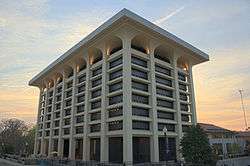
Emory University is a member of the Association of Research Libraries.[85] The Emory University library system includes over 3.9 million print and electronic volumes and 83,000-plus electronic journals.[86][87] Emory University libraries include the Robert W. Woodruff Library, Woodruff Health Sciences Center Library, Hugh F. MacMillan and Yuddhishtir Modhwadia Law Library, James S. Guy Chemistry Library, Pitts Theology Library, Goizueta Business Library, Marian K. Heilbrun Music & Media Library, and the Stuart A. Rose Manuscript, Archives, and Rare Book Library (The Rose Library).[86][88] The Rose Library contains rare materials relating to literature, African American history and culture, and Southern and Georgia history.[86][87] Notable pieces of the collection include a rare first edition of Robinson Crusoe by Daniel Defoe,[89] as well as works by Flannery O'Connor, Alice Walker, Langston Hughes, W.B. Yeats, and Seamus Heaney.[90]
Subject specialist librarians provided research assistance for every academic department at the university.[91] The Annual Robert W. Woodruff Library Undergraduate Research Award recognizes undergraduate students who make extensive use of Woodruff Library's collections and research resources in their original scholarship and show evidence of critical analysis in their research skills.[92]
In 2012, the Princeton Review ranked the Robert W. Woodruff Library among the top 10 "Best College Libraries" in the United States.[93] In 2013, the Pitts Theology Library of the Candler School of Theology was named as one of "Most Beautiful College Libraries in the World."[94]
Rankings and reputation
| University rankings | |
|---|---|
| National | |
| ARWU[95] | 46–58 |
| Forbes[96] | 55 |
| THE/WSJ[97] | 22 |
| U.S. News & World Report[98] | 21 |
| Washington Monthly[99] | 83 |
| Global | |
| ARWU[100] | 101–150 |
| QS[101] | 156 |
| THE[102] | 80 |
| U.S. News & World Report[103] | 71 |
|
USNWR graduate school rankings[104] | |
|---|---|
| Biological Sciences | 33 |
| Business | 22 |
| Chemistry | 32 |
| Clinical Psychology | 18 |
| Computer Science | 82 |
| Economics | 63 |
| English | 30 |
| History | 27 |
| Mathematics | 55 |
| Law | 24 |
| Medicine: Primary Care | 25 |
| Medicine: Research | 24 |
| Nursing: Doctorate | 8 |
| Nursing: Masters | 5 |
| Nursing – Midwifery | 8 |
| Physical Therapy | 8 |
| Physician Assistant | 5 |
| Physics | 71 |
| Political Science | 24 |
| Psychology | 36 |
| Public Health | 5 |
| Sociology | 36 |
| Statistics | 37 |
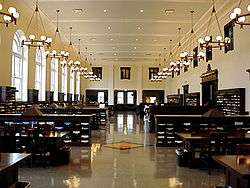
Emory University is ranked 21st among national universities in the United States and 71st among global universities by U.S. News & World Report, 98th among global universities and 19th in the United States in the Times Higher Education World University Rankings for 2017–18.[105] QS University Rankings listed Emory as 27th in the United States. [106] The university has been named both a Hidden Ivy and a "New Ivy."[107] The university was ranked 17th among colleges and universities in the United States in a Wall Street Journal survey.[108] Emory is considered to have one of the best writing programs in the United States and was ranked 1st among the list of the best colleges and universities for writers by The Huffington Post and USA Today in 2012.[109][110]
The Princeton Review named the Emory University School of Law as one of the best 169 law schools in the U.S. in 2014. Bloomberg Businessweek ranked Goizueta Business School's BBA Program 9th in the nation in 2014. The Economist ranked Goizueta Business School's MBA program 27th in the nation in 2019.[111]
In 2012, following an internal investigation led by Emory Provost Earl Lewis and Jones Day Law Firm, Emory University announced that members of Emory University's Office of Admission and Institutional Research intentionally misreported data concerning entering students' standardized test scores and class rankings between 2000 and 2012 to standard reference sources and third parties who rank colleges and universities.[112] For example, while the office reported that 89% of its students graduated in the top 10% of their class, only 75% actually had. Following the investigation, the individuals responsible for the misreportings were fired or resigned and the university issued a public apology.[113] The university made several corrective actions in 2012 and 2013, including the hiring of independent data advisers, to ensure accurate data collection and reporting in the future.[114]
Research

Emory University is classified among "R1: Doctoral Universities – Very high research activity."[115] In 2015, Emory received $572.4 million from external funding agencies.[116] Emory University leads the nation in the number of students with Kirschstein-National Research Service Award pre-doctoral fellowships from the National Institutes of Health.[117]
Emory University has a strong partnership with the Centers for Disease Control and Prevention (CDC). In 1947, the university donated 15 acres of land to the United States Department of Health and Human Services for the construction of the CDC headquarters.[118] The Emory University Prevention Research Center (EPRC) and Emory Center for Injury Control are funded by the CDC.[33][119] Emory University's African Center of Excellence for Public Health Security, which seeks to improve preparedness and response to health threats in low-income countries, is a five-year, multimillion-dollar cooperative program with the CDC and International Association of National Public Health Institutes (IANPHI).[120] The Emory University Center for Global Safe Water (CGSW), which conducts applied research, evaluation, and training to promote global health equity through universal access to safe water, sanitation, and hygiene, works in collaboration with the CDC.[121][122] The Emory University Global Health Institute, funded by the Bill & Melinda Gates Foundation, partners with the CDC to enhance public health infrastructure in low-resource countries.[123] The Emory University Hospital Isolation Unit and Quarantine Station was established by the CDC following the 2003 SARS outbreak.[124] The isolation and treatment facilities at Emory University played a crucial role in ending the 2014 Ebola virus cases in the United States.[125] CDC scientists and administrators hold memberships and frequently speak at Emory University's Vaccine Dinner Club (VDC), an association that holds monthly academic meetings to discuss and advance vaccine research.[126] In 2015, Emory was made a member of the CDC's Prevention Epicenters Program, a research program in which CDC's Division of Healthcare Quality Promotion (DHQP) collaborates with academic investigators to conduct innovative infection control and prevention research.[127][128]
In 2015, Emory University, the London School of Hygiene & Tropical Medicine, the Public Health Foundation of India, and the All India Institute of Medical Sciences established the Center for Control of Chronic Conditions in New Delhi, India. The center aims to improve the prevention and care of diabetes, heart disease, cancer, mental health, and injuries in India.[129]
The International Association of National Public Health Institutes is based at the university. The association was chartered in 2006 with a $20 million, five-year grant through Emory University from the Bill and Melinda Gates Foundation. In 2015, the Emory Global Health Institute and Centers for Disease Control and Prevention were made lead partners for the newly created, $75 million Bill and Melinda Gates Foundation-funded Child Health and Mortality Prevention Surveillance Network (CHAMPS).[130]
Emory University research is heavily funded by the United States Department of Health and Human Services's National Institutes of Health.[43] The federal agency awarded the university nearly $300 million in the fiscal year of 2015.[116] In 2015, Emory University was one of four institutions selected by the National Institute of Allergy and Infectious Diseases for its seven-year, multimillion-dollar Tuberculosis Research Units (TBRU) program, which aims to drive innovation in tuberculosis research and reduce the global burden of the disease.[36] In 2015, an Emory-led research consortium received a five-year, $15 million grant from the National Institutes of Health (NIH) to research human immune responses to Varicella zoster virus and pneumococcal vaccination.[131] The university also received a $9 million grant over five years from the NIH to support one of three national Centers for Collaborative Research in Fragile X syndrome. The grant is a renewal of Emory's National Fragile X Research Center, continuously funded by the NIH for more than 10 years.[116] In 2015, the university received an $8.9 million grant over five years from the NIH National Heart, Lung, and Blood Institute (NHLBI) to better understand the role of reactive oxygen species and inflammation in blood vessel function and to explore new interventions and preventive approaches for atherosclerosis and aortic aneurysms.[116] In 2015, the university received an $8 million grant over five years from the NIH to develop and validate mathematical models of how prior immunity affects recall immune responses to influenza viruses. The researchers will create and disseminate powerful, user-friendly modeling tools for use by the wider research community in developing more effective vaccines.[116] In 2015, the university received a $3.6 million grant over five years from the NIH to examine the effects of maternal stress on brain function, development, and behavior in African-American infants, including the biochemical connection between the brain and the microbiome.[116] In 2015, the university received a $3.5 million grant over five years from the NIH National Cancer Institute (NCI) for an Informatics Technology for Cancer Research award. Winship Cancer Institute and Emory School of Medicine researchers will develop software tools to help the cancer research community gain new insights from cancer imaging "big data" and develop new open-source cancer research applications.[116] In 2015, the university received a $3.4 million grant from the NIH International Collaborations in Infectious Disease Research Program to support a partnership between the Emory Vaccine Center and the International Centre for Genetic Engineering and Biotechnology (ICGEB) in New Delhi, India to study dengue virus infection in India.[116]
The Emory University Center for AIDS Research (CFAR) and the Emory Vaccine Center are world leaders in AIDS Vaccine Development and HIV Pathogenesis studies are funded by nine different institutes of the National Institutes of Health and by the Georgia Research Alliance.[32] The centers include one of the largest groups of academic vaccine scientists in the world and are currently attempting to develop an effective HIV vaccine.[132] Emory University Researchers Dr. Dennis C. Liotta, Dr. Raymond F. Schinazi and Dr. Woo-Baeg Choi discovered Emtricitabine, a nucleoside reverse transcriptase inhibitor (NRTI) used in the treatment of HIV. The drug was named as one of the world's most important antiviral drugs by the World Health Organization and is included in their Model List of Essential Medicines.[133]
Emory University is a global leader in Ebola research and treatment. The university was one of three institutions that successfully treated medical evacuees during the 2014 Ebola outbreak. In 2015, the United States Department of Health and Human Services named Emory University the lead coordinating center for the National Ebola Training and Education Center (NETEC).[35] The university will collaborate with the University of Nebraska Medical Center, the New York City Health and Hospitals Corporation, the Centers for Disease Control and Prevention and the Office of the Assistant Secretary for Preparedness and Response on the program, which will receive $12 million in funding over the next five years. The program will support training of health care providers and facilities to manage Ebola and other emerging infectious diseases. Its objectives are to develop metrics to measure facility and health care worker readiness to care for Ebola patients, conduct assessments of state and regional Ebola Treatment Centers, create education materials related to care of patients with possible Ebola and other special pathogens and offer technical and training assistance to public health departments and health facilities.[35] The university also received a $10.8 million grant over three years from the U.S. Department of Defense's Defense Advanced Research Projects Agency (DARPA) to lead a 10-institution national team developing improved therapeutics and vaccines for multiple strains of Ebola virus.[116] In 2015, Emory received a three-year, $2.2 million grant from the CDC to prevent the spread of infectious diseases, including Ebola, in health-care facilities.[128]
Emory and the Georgia Institute of Technology (Georgia Tech) have a strong research partnership. In 2015, Emory and Georgia Tech were awarded an $8.3 million grant by the NIH to establish a National Exposure Assessment Laboratory.[134] The laboratory will research the impact of environmental chemicals on children's health.[134] In 2015, the two universities received a five-year, $2.9 million grant from the National Science Foundation (NSF) to create new bachelor's, master's, and doctoral degree programs and concentrations in healthcare robotics, which will be the first program of its kind in the Southeastern United States.[135] In 2015, Emory University, Georgia Tech, and Children's Healthcare of Atlanta were awarded a four-year, $1.8 million grant by the Cystic Fibrosis Foundation in order to expand the Atlanta Cystic Fibrosis Research and Development Program. As of 2015, Emory jointly manages the second-largest cystic fibrosis population in the United States.[34] In 2015, Emory and Georgia Tech received a $1.6 million grant from the Coulter Translational Research Partnership Program to accelerate nine promising technologies developed in research laboratories with commercialization potential.[116]
In 2015, Emory University received a $15 million grant from the Wounded Warrior Project in order to establish the "Warrior Care Network" and develop innovative approaches to treat veterans with post-traumatic stress disorder (PTSD) and traumatic brain injury (TBI).[136]
In 2015, Emory University and the University of South Florida received a $2.5 million grant over five years from the John E. Fogarty International Center (FIC) to study links between infectious disease transmission and agricultural practices.[116]
Campus
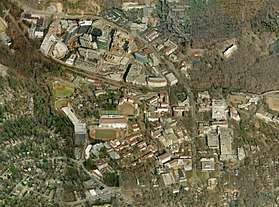
Emory University's original campus was established in Oxford, Georgia in 1836. The 56-acre campus, located 38 miles east of Emory's main Atlanta campus, is home to Oxford College of Emory University and was the site of military headquarters and infirmaries during the American Civil War.[51] Many of the buildings were designed with Neoclassical architecture and Gothic Revival architecture. In 1975, the United States National Register of Historic Places designated the campus as part of the Oxford Historic District.[137]
Emory's main Atlanta campus, established in the early twentieth century on a Beaux-Arts master plan by Pittsburgh architect Henry Hornbostel,[138] covers more than 600 acres in Atlanta's historic neighborhood of Druid Hills. The university campus is heavily forested with pine, maples, oak, and magnolias, and Peavine Creek, a branch of the Peachtree Creek, runs through the campus. The Arbor Day Foundation named Emory a Tree Campus USA school in 2015.[139] Many of the university's buildings are designed with multi-hued granite and Spanish Saltillo tile. The university has one of the largest inventories by square footage of Leadership in Energy and Environmental Design-certified building space among campuses in the United States.[140]
The campus is home to the Emory University Hospital, Michael C. Carlos Museum, which has the largest collection of ancient artifacts in the Southeastern United States, the Winship Cancer Institute, Georgia's first and only cancer center designated by the National Cancer Institute,[141] the Yerkes National Primate Research Center, one of eight National Institutes of Health-funded national primate research centers, and a number of other academic, art, medical, and student facilitates. Undergraduate dormitories include the Undergraduate Residential Center, Clairmont Residential Center, Tower Apartments, Alabama Hall, Complex, Dobbs Hall, Holmes Hall, Longstreet-Means Hall, Raoul Hall and Turman Hall. The Centers for Disease Control and Prevention, American Cancer Society, Children's Healthcare of Atlanta Egleston hospital, and Emory Point are located adjacent to the campus. In 1991, Emory opened the first collegiate LGBT support office in the Southeast which is the 10th oldest in the nation.[142]
In 2015, a $52 million expansion and renovation project of the Sanford S. Atwood Chemistry Center was completed. The new, 270,000-square-foot complex contains laboratories, interactive teaching and study spaces, and a chemistry library.[143] The completion of the complex was accompanied by a $1.2 million grant from the Howard Hughes Medical Institute to advance and modernize the university's chemistry curriculum.[143]
In the Candler Library Annex of Robert W. Woodruff Library, there is a 1920s Pietro Caproni reproduction of Bertel Thorvaldsen's "The Triumph of Alexander" frieze. The frieze depicts Alexander the Great and his army entering Babylon following their victory over the Achaemenid Empire in the Battle of Gaugamela.[144]
During the 1996 Summer Olympics in Atlanta, the university hosted the United States Olympic women's gymnastics team on its main campus.[145] The team, known as the Magnificent Seven, won the first-ever gold medal for the United States in the women's team all-around competition. The university housed international officials and journalists and served as a training facility for Olympians. The Cox Hall Ballroom was transformed into a news center for the Olympic foreign press.[145]
In February 2017, Emory announced that its R. Howard Dobbs University Center, built in 1986 from a neofuturistic postmodernist design by local architect John C. Portman Jr., to house the university's main student/faculty center and dining hall (Coca-Cola Commons), would be demolished and replaced with a new $98 million Campus Life Center, designed by Durham, North Carolina-based Duda Paine Architects. Reasons given for the replacement included inconvenience of food delivery to the dining hall, undersized kitchen facilities, and inadequate fenestration in the Commons.[138]
Student life
| Undergraduate and Graduate | |
|---|---|
| Asian/Pacific Islander | 17% |
| Black/Non-Hispanic | 10% |
| Hispanics of any race | 8% |
| White/non-Hispanic | 42% |
| Mixed Race/Other | 6% |
| International students | 17% |
Student body
Emory University's total enrollment for fall 2019 was 15,398 students, with 8,101 undergraduates and 7,297 graduate and professional students. 26% of students are Georgia residents, the remaining come from 49 other states, D.C., and more than 100 countries. 40% of students are male, 60% are female.[147] The student to faculty ratio is 7:1, with an average class size of 25 students.[148]
Of the 1,392 freshmen enrolled in fall 2019, 30% were Caucasian, 24% were Asian, 14% were Black/African American, 13% were Latinx/Hispanic, 13% were International and 6% did not identity; 57% were female and 43% were male.[149]
Arts
Students may engage in the performing and fine arts as an area of academic study or as extracurricular activities. Undergraduates may pursue a major in the performing arts (dance, theater, or music) or in film studies, art history, visual arts, or creative writing.[150] Graduate programs in art history, film studies, and music are offered.[151] There are more than 50 student organizations dedicated to the arts. Students can explore artistic interests as diverse as architecture, breakdancing, poetry, and improvisational comedy.[152] Emory routinely hosts arts events in the Schwartz Center for Performing Arts that are open to the Emory and Atlanta communities. Recent performances include Bang on a Can All-Stars (a side project of drummer Glenn Kotche from the rock band Wilco), jazz performer Esperanza Spalding, and New York's Cedar Lake Dance Company. A program called Creativity Conversations brings artistic minds to campus to discuss art and the creative process. Guests have included Philip Glass, Jimmy Carter, Salman Rushdie, Seamus Heaney and Rita Dove.[153][154][155] Rita Dove also gave the keynote address at Emory's 2013 Commencement.[156]
Athletics
Emory ranks among top schools in both the U.S. News & World Report's rankings of the best national universities and the Directors Cup of the National Association of Collegiate Directors of Athletics for best all-around athletics program.[157] Emory's 18 varsity sports teams, known as the Eagles, are members of the NCAA's Division III University Athletic Association (UAA). However, Emory does not have an intercollegiate football team.[158]
Barkley Forum
The Barkley Forum Center for Debate Education is an intercollegiate debate organization at Emory University.[159] The center is named in honor of Emory alumnus Alben Barkley, 35th Vice President of the United States. Debating was established at the university in 1837 and the intercollegiate debate team was formed in 1914. Emory's Barkley Forum debate team has won 3 National Debate Tournaments and over 25 individual champion speaker awards.[160]
Community service
The university received the 2008 Presidential Award for General Community Service, which is the highest federal recognition given to higher education institutions for their commitment to community service, service-learning and civic engagement.[161] About 25% of Emory students participate in Volunteer Emory, Emory's umbrella community service group. As one of the most popular groups on campus, Volunteer Emory offers dozens of ways to serve the community, working with varied organizations including the Atlanta Community Food Bank, Trees Atlanta, PAWS Atlanta, and Jones Boys and Girls Club.[162] Emory Cares International Service Day brings together students, alumni and other community members to volunteer at a number of projects organized by Emory and its many partners around the city of Atlanta and in cities worldwide.[163]
Newspaper
The Emory Wheel is the student-run newspaper of Emory University. The Wheel is published twice a week, on Tuesday and Friday, during the regular school year, and is updated regularly at its website. Serving the Emory community since 1919, the Wheel is editorially and financially independent from the university. The staff is composed entirely of students, with the exception of the general manager, who oversees advertising and whose salary is paid by the newspaper.[164][165]
Programs abroad
Through the Centers of International Programs Abroad, Emory University students can study in over 40 countries at the top academic institutions in the world including the National University of Singapore, Kyoto Consortium for Japanese Studies, Nanjing University, Oxford University, Imperial College London, the School of Oriental and African Studies, Yonsei University, Trinity College Dublin, University of St. Andrews, University of Melbourne, Hertie School of Governance, University of Amsterdam, Sciences Po, University of Cape Town, and Tel Aviv University.[166]
Greek life
Fraternities have existed on Emory's campus as early as 1840. One early chronicler makes the case that Emory's "temple" of the Mystic Seven may have been the first chapter of a national fraternity established anywhere in the South. Today, the Greek-letter sororities and fraternities play a part in leavening Emory's campus life. For undergraduates, Greek life comprises approximately 30% of the Emory student population. The Office of Greek Life recognizes and regulates on-campus chapters of fraternities and sororities. Fraternities have on-campus housing located on Eagle Row, and Sorority Village, a series of townhouses, faces the fraternity houses.[167]
Student organizations
Hundreds of student clubs and organizations operate on Emory's campus. These include numerous student government, special interest, and service organizations.The Student Government Association (SGA) charters and provides most of the funding for other student groups, and represents students' interests when dealing with the administration.[168] The SGA oversees divisional councils, each coinciding with the undergraduate, graduate and professional schools of the university. Notable among these are the College Council (CC) which handles students' concerns primarily for the undergraduate body of the Emory College of Arts and Sciences and annually sponsors the State of Race event, and the BBA Council which does similar activities for the Goizueta Business School BBA Program. The Student Programming Council (SPC) is the school's primary programming organization, responsible for planning multiple events every year: Homecoming Week, Dooley's week, and a plethora of other events that happen around campus that benefit the students in a proactive way.[169] Emory also has several secret societies—the Paladin Society, the D.V.S. Senior Honor Society, Ducemus, Speculum, and The Order of Ammon.[170] Emory has a partnership with Coca-Cola in which they pledged 3 million dollars over a 5-year period for "Service for Learning" which projects that Emory student volunteers participate to help preserve nature trails, create urban farms, as well as restore neighborhood parks.[171] Emory University also has many Black student organizations, including: the Black Student Alliance, the National Association for the Advancement of Colored People (NAACP), and Voices of Inner Strength Gospel Choir (VOIS).
The intramural sports program provides an athletic outlet for the entire Emory community. Emory has numerous club sports[172] and a variety of recreational and competitive intramural teams.[173] The Outdoor Emory Organization sponsors weekend trips of outdoor activities such as rafting, rock climbing and hiking.[174]
Notable alumni and faculty
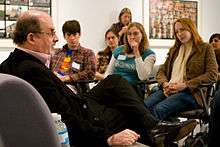
Emory University has over 13,200 faculty and staff members and over 133,000 living alumni. Awards and honors recognizing Emory alumni and faculty include the Nobel Prize, Pulitzer Prize, Presidential Medal of Freedom, Bancroft Prize, Booker Prize, Lenore Marshall Poetry Prize, National Humanities Medal, Peabody Award, Breakthrough Prize in Life Sciences, Guggenheim Fellowship, Fulbright Fellowship, American Mathematical Society Fellowship, MacArthur Fellows Program, Rhodes Scholarship, Marshall Scholarship, and membership in the American Academy of Arts and Sciences, Carnegie Foundation for the Advancement of Teaching, Howard Hughes Medical Institute, American Society for Clinical Investigation, National Academy of Sciences, and National Research Council.[175][176]
Notable Alumni: Alben Barkley (BA 1900), 35th Vice President of the United States; Isaac Stiles Hopkins (1859C) and Robert Stewart Hyer (BA 1881, MA 1882), founding presidents of Georgia Institute of Technology and Southern Methodist University, respectively; Young John Allen (1858C), American Methodist Missionary in the late Qing Dynasty, China; Thomas Milton Rivers (1909C), Director of the Rockefeller Institute; Ernest Cadman Colwell (1923C, 1927PhD), President of the University of Chicago; Bobby Jones (Law 1929), the only golfer to win a Grand Slam, founder of the Masters Golf Tournament, and regarded as one of the greatest golfers of all time; Ely Callaway Jr. (1940C), Founder of the Callaway Golf Company; Ernie Harwell (1940C), baseball broadcaster for the Detroit Tigers; Arnall Patz (BA 1943, MD 1945), ophthalmology researcher and Presidential Medal of Freedom recipient; Lewis Roger Slaton (1949JD), District Attorney, Fulton County, Georgia; Lee Hong-koo (1959C), 26th Prime Minister of the Republic of Korea; Newt Gingrich (BA 1965), 58th Speaker of the House of Representatives; Sonny Carter, NASA astronaut, Crew member of STS-33 Space Shuttle mission (1969C); Peter Buck, guitarist for the band R.E.M.; Kenneth Cole (BA 1976), clothing designer and founder of Kenneth Cole Productions; Christopher McCandless (1990C), Alaskan wilderness adventurer and main subject of Jon Krakauer's Into the Wild; Fala Chen (2005C), Chinese American Actress; Kirsten Haglund (2013C), Miss America 2008; Duncan L. Niederauer, Chief Executive Officer of the New York Stock Exchange (NYSE).[177]
Distinguished faculty: Jimmy Carter, 39th President of the United States; Sir Salman Rushdie, Booker Prize-winning novelist; Tenzin Gyatso, the 14th Dalai Lama; Desmond Tutu, Nobel Peace Prize recipient; William Foege, 10th Centers for Disease Control and Prevention Director; Nathan McCall, New York Times bestselling author;[178] James T. Laney, 17th President of Emory University, United States Ambassador to Korea from 1993 to 1997; Natasha Trethewey, Pulitzer Prize winner; and US Poet Laureate and Dr. Sanjay Gupta, CNN chief medical correspondent.[179][180]
 Alben Barkley, 35th Vice President of the United States (1900C, 1949H)
Alben Barkley, 35th Vice President of the United States (1900C, 1949H) Isaac S. Hopkins, First President of the Georgia Institute of Technology (1859C)
Isaac S. Hopkins, First President of the Georgia Institute of Technology (1859C)
 Thomas Milton Rivers, Director of Rockefeller Institute, "Father of Modern Virology" (1909C)
Thomas Milton Rivers, Director of Rockefeller Institute, "Father of Modern Virology" (1909C)
 Robert W. Woodruff, President of The Coca-Cola Company from 1923 until 1954
Robert W. Woodruff, President of The Coca-Cola Company from 1923 until 1954 Kiyoshi Tanimoto, Hibakusha portrayed in John Hersey's Hiroshima, Organized the Hiroshima Maidens Program (1940T, 1986H)
Kiyoshi Tanimoto, Hibakusha portrayed in John Hersey's Hiroshima, Organized the Hiroshima Maidens Program (1940T, 1986H)
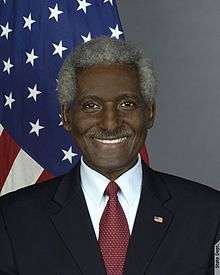
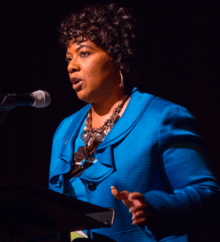 Bernice King, American minister and activist, the youngest child of Martin Luther King, Jr. and Coretta Scott King (1990JD)
Bernice King, American minister and activist, the youngest child of Martin Luther King, Jr. and Coretta Scott King (1990JD) Natasha Trethewey, 19th US Poet Laureate, Robert W. Woodruff Professor of English and Creative Writing
Natasha Trethewey, 19th US Poet Laureate, Robert W. Woodruff Professor of English and Creative Writing Desmond Tutu, South African social rights activist, Recipient of 1984 Nobel Peace Prize for opposition to Apartheid (Professor)
Desmond Tutu, South African social rights activist, Recipient of 1984 Nobel Peace Prize for opposition to Apartheid (Professor)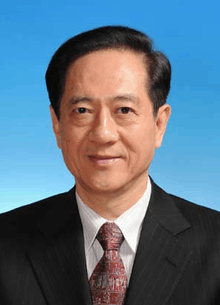 Han Qide Vice Chairman of National People's Congress, People's Republic of China (Professor)
Han Qide Vice Chairman of National People's Congress, People's Republic of China (Professor)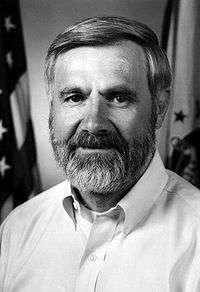 William Foege, 10th Centers for Disease Control and Prevention Director, Credited for global eradication of Smallpox (Professor)
William Foege, 10th Centers for Disease Control and Prevention Director, Credited for global eradication of Smallpox (Professor)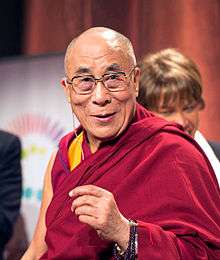 Tenzin Gyatso, 14th Dalai Lama, Recipient of 1989 Nobel Peace Prize and Congressional Gold Medal in 2007 (Professor)
Tenzin Gyatso, 14th Dalai Lama, Recipient of 1989 Nobel Peace Prize and Congressional Gold Medal in 2007 (Professor) Jimmy Carter, 39th President of the United States, Recipient of 2002 Nobel Peace Prize (Professor)
Jimmy Carter, 39th President of the United States, Recipient of 2002 Nobel Peace Prize (Professor) Jim Sarbh, Bollywood Actor/Director, (2009C)
Jim Sarbh, Bollywood Actor/Director, (2009C)
References
- "Emory College of Arts and Sciences". emory.edu. Emory University. Archived from the original on December 14, 2018. Retrieved December 7, 2018.
- "Emory University History". Emoryhistory.emory.edu. Retrieved February 22, 2014.
- Separated brethren: a review of Protestant, Anglican, Eastern Orthodox & other religions in the United States. Our Sunday Visitor. 2002. ISBN 9781931709057. Retrieved March 27, 2010.
Among Protestant denominations, Methodists take first place in hospitals and colleges. Some of their one hundred colleges and universities have all but severed ties with the denominations, but others remain definitely Methodist: Syracuse, Boston, Emory, Duke, Drew, Denver, and Southern Methodist. The church operates 360 schools and institutions overseas. Methodists established Goodwill Industries in 1907 to help handicapped persons help themselves by repairing and selling old furniture and clothes. The United Methodist Church runs seventy-two hospitals in the United States.
- "Schools by Jurisdiction". United Methodist Church. Archived from the original on December 16, 2009. Retrieved November 26, 2009.
- As of June 30, 2019. "U.S. and Canadian 2019 NTSE Participating Institutions Listed by Fiscal Year 2019 Endowment Market Value, and Percentage Change in Market Value from FY18 to FY19 (Revised)". National Association of College and University Business Officers and TIAA. Retrieved April 19, 2020.
- "Office of the President". Retrieved August 2, 2020.
- "Facts and Figures". Emory University. Retrieved September 28, 2017.
- "The Emory Wheel Endowment". Emorywheel.com. Retrieved October 20, 2017.
- "Emory University Identity Colors". Archived from the original on February 15, 2014. Retrieved February 22, 2014.
- "Emory University NCAA". Retrieved February 22, 2014.
- "Association of American Universities". Aau.edu. Retrieved October 20, 2017.
- "SACS". Aau.edu. Retrieved October 20, 2017.
- "ACE". 2.acenet.edu. Retrieved October 20, 2017.
- NAICU – Member Directory Archived November 9, 2015, at the Wayback Machine
- "International Association of Methodist Schools, Colleges, and Universities (IAMSCU) – General Board of Higher Education and Ministry". November 11, 2016. Archived from the original on November 11, 2016. Retrieved October 20, 2017.CS1 maint: BOT: original-url status unknown (link)
- "ORAU Emory University". Orau.org. Archived from the original on February 22, 2015. Retrieved October 20, 2017.
- Niesse, Mark. "City of Atlanta's expansion to Emory and CDC approved". Atlanta Journal-Constitution. Retrieved December 5, 2017.
- "Emory: History & Traditions". Emory.edu. Retrieved October 20, 2017.
- "New Georgia Encyclopedia:Emory University". Georgiaencyclopedia.org. Retrieved October 20, 2017.
- "Emory Board of Trustees names Gregory L. Fenves as 21st president". news.emory.edu. April 7, 2020. Retrieved August 14, 2020.
- "Emory University website". Retrieved July 18, 2011.
- "Georgia Tech / Emory / Peking University BME PhD Program". Bme.gatech.edu. Retrieved October 20, 2017.
- "Wallace H. Coulter Department of Biomedical Engineering Program". Nme.gatech.edu. Retrieved October 20, 2017.
- "Confucius Institutes Around the Globe". Confuciusinstitute.unl.edu. Retrieved October 20, 2017.
- "Confucius Institute in Atlanta". Confuciu.emory.edu. Retrieved October 20, 2017.
- "Georgia Tech-Emory-KAIST Biomedical Engineering Faculty". Kaist.edu. Retrieved October 20, 2017.
- "Summer Biomedical Engineering Workshop in Daejeon, South Korea". Bme.gatech.edu. Retrieved October 20, 2017.
- Figg, Travis M; Park, Sehoon; Park, Juhyeon; Chang, Sukbok; Musaev, Djamaladdin G (2014). "Comparative Investigations of Cp*-Based Group 9 Metal-Catalyzed Direct C–H Amination of Benzamides". Organometallics. 33 (15): 4076–4085. doi:10.1021/om5005868.
- "Emory University International Students". Emory.edu. Retrieved October 20, 2017.
- Emory Healthcare. "About Emory Healthcare". Retrieved August 3, 2011.
- "Archived copy". Archived from the original on February 22, 2015. Retrieved March 31, 2015.CS1 maint: archived copy as title (link)
- "Center for AIDS Research". Cfar.emory.edu. Retrieved October 20, 2017.
- "Prevention Research Center". Cdc.gov. Archived from the original on May 15, 2016. Retrieved October 20, 2017.
- "Cystic Fibrosis Foundation Grants $1.8 million to Expand the Atlanta CF Research and Development Program". Cysticfibrosisnewstoday.com. Retrieved October 20, 2017.
- "Emory University to lead National Ebola Training and Education Center". Bizjournals.com. Retrieved October 20, 2017.
- "NIH Tuberculosis Research Program". Niaid.nih.gov. Retrieved October 20, 2017.
- "History". Ianphi.org. Archived from the original on April 28, 2013. Retrieved October 20, 2017.
- "Facilities & Affiliations -- School of Medicine, Emory University". Med.emory.edu. Archived from the original on October 20, 2017. Retrieved October 20, 2017.
- "The Carter Center – Waging Peace. Fighting Disease". The Carter Center.
- "Carnegie Classifications - Institution Profile". Indiana University Center for Postsecondary Research. Retrieved March 30, 2020.
- "CWTS Leiden Ranking". Leidenranking.comAau.edu. Retrieved October 20, 2017.
- "Archived copy". Archived from the original on January 13, 2017. Retrieved January 19, 2017.CS1 maint: archived copy as title (link)
- "Emory University gets record $572.4M in external research funding in 2015". Bizjournals.gov. Retrieved October 20, 2017.
- "Famous Alumni - Points of Pride - Emory University - Emory University - Atlanta, GA". www.emory.edu.
- "About Us". alumni.emory.edu. Retrieved November 17, 2018.
- alumni.emory.edu http://www.alumni.emory.edu/groups/chapters.html. Retrieved November 17, 2018. Missing or empty
|title=(help) - "New Georgia Encyclopedia, Asa Candler (1851-1929)". Georgiaencyclopedia.org. Retrieved October 20, 2017.
- "Road Trip: Emory University". Usnews.com. Retrieved October 20, 2017.
- Hauk, Gary S. "A Brief History". Emory University. Archived from the original on October 30, 2013. Retrieved May 27, 2009.
- "George Thomas Anderson". Findagrave.com. Retrieved October 20, 2017.
- English, Thomas H. Emory University 1915–1965: A Semicentennial History (Atlanta: Emory University, 1966).
- "A Direct Line to Emory's History - Emory University - Atlanta, GA". shared.web.emory.edu. Retrieved October 20, 2017.
- "애국가". Academy of Korean Studies. Retrieved October 8, 2013.
- "South Korea – Aegukga". NationalAnthems.me. Archived from the original on April 24, 2012. Retrieved November 17, 2011.
- "A look inside the WWII surrender ceremony". Latimes.com. Retrieved October 20, 2017.
- Frost, Mark (2004). The Grand Slam: Bobby Jones, America, and the Story of Golf. New York: Hyperion Books. pp. 458–9. ISBN 978-1-4013-0751-6.
- Weinstein, Alfred (December 19, 2013). Alfred A. Weinstein. ISBN 978-1937565961.
- "Kiyoshi Tanimoto". Emoryhistory.emory.edu. Retrieved October 20, 2017.
- "New Georgia Encyclopedia, Emory University". Georgiaencyclopedia.org. Retrieved October 20, 2017.
- "Kim Dae Jung speech, 1983". Findingaids.library.emory.edu. Retrieved October 20, 2017.
- "Kim Dae Jung Facts". Kdjlibrary.library.emory.edu. Retrieved October 20, 2017.
- "Emory University President's Medal". President.emory.edu. Archived from the original on April 15, 2016. Retrieved October 20, 2017.
- "Emory to establish John Lewis Chair in Civil Rights, Social Justice". News.emory.edu. Retrieved October 20, 2017.
- Niesse, Mark (August 23, 2016). "Atlanta may expand to cover Emory University". Atlanta Journal-Constitution. Retrieved March 10, 2020.
Emory University hopes to make official what many outside the metropolitan area already assume to be the case:[...]
- "2010 CENSUS - CENSUS BLOCK MAP: Druid Hills CDP, GA." U.S. Census Bureau. Retrieved on June 1, 2017. Compare this with the address of Emory University (2016 home page states: "201 Dowman Drive, Atlanta, Georgia 30322 USA") and the location of its buildings.
- Chess, Richard; Madison Bober (December 4, 2017). "Emory, CDC to be Annexed into Atlanta". Emory Wheel. Retrieved March 11, 2020.
- Stafford, Leon (June 27, 2017). "Emory University formally files petition to become part of Atlanta". Atlanta Journal-Constitution. Retrieved March 10, 2020.
- "Emory University Common Data Set".
- "Admissions Factbook".
- "Emory's Class of 2023". news.emory.edu. Retrieved January 5, 2020.
- Emory University http://news.emory.edu/features/2020/03/admission-class-of-2024/index.html#group-Academic-Leaders-01UZDKvVkd. Retrieved April 1, 2020. Missing or empty
|title=(help) - https://apply.emory.edu/discover/facts-stats/first-year.html
- "Honors Program". catalog.college.emory.edu.
- https://apply.emory.edu/academics/applying-knowledge.html
- "Emory College of Arts and Sciences website". Archived from the original on August 26, 2011. Retrieved July 18, 2011.
- "UGA, Emory University partner to offer dual master's degree in social work, divinity". Bizjournals.com. Retrieved May 18, 2015.
- "Oxford College, Divisions & Courses".
- "Emory University School of Medicine, Departments and Centers". Med.emory.edu. Retrieved October 20, 2017.
- "Nell Hodgson Woodruff School of Nursing". Archived from the original on January 9, 2015.
- "Candler School of Theology >> Single Degrees". candler.emory.edu. Archived from the original on May 22, 2016. Retrieved October 20, 2017.
- "Emory Law - Emory University School of Law - Atlanta, GA". Emory University School of Law. Retrieved October 20, 2017.
- "Laney Graduate School, Degrees". Emory.edu. Retrieved October 20, 2017.
- "Goizueta Business School". Goizueta.emory.edu. Retrieved October 20, 2017.
- "Rollins School of Public Health, Degrees". Emory.edu. Retrieved October 20, 2017.
- Administrator. "List of ARL Members - Association of Research Libraries® - ARL®". Arl.org. Retrieved October 20, 2017.
- "Archived copy". Archived from the original on July 24, 2015. Retrieved July 23, 2015.CS1 maint: archived copy as title (link)
- "Academics - Emory Libraries Resources for Emory University - UniversityParent". Universityparent.com. Retrieved October 20, 2017.
- "Emory University Libraries and Information Technology". Web.library.emory.edu. Retrieved October 20, 2017l.
- "MARBL Receives 'Crusoe' Editions". The Emory Wheel. November 24, 2008. Archived from the original on July 10, 2011. Retrieved August 3, 2010.
- "Emory archive acquires Atlanta Contemporary Art Center's records". Artsculture.blog.ajc.com. Archived from the original on July 24, 2015. Retrieved October 20, 2017.
- "Subject Librarians". Web.library.emory.edu. Robert W. Woodruff Library. Retrieved October 20, 2017.
- "Robert W. Woodruff Library, Award and Research Programs". Web.library.emory.edu. Retrieved October 20, 2017.
- "The 10 Colleges With The Best Libraries: Princeton Review List". Huffingtonpost.com. Retrieved October 20, 2017.
- "The Most Beautiful College Libraries in the World, Flavorwire". Flavorwire.com. Archived from the original on January 10, 2015. Retrieved October 20, 2017.
- "Academic Ranking of World Universities 2020: National/Regional Rank". Shanghai Ranking Consultancy. Retrieved August 15, 2020.
- "America's Top Colleges 2019". Forbes. Retrieved August 15, 2019.
- "U.S. College Rankings 2020". Wall Street Journal/Times Higher Education. Retrieved September 26, 2019.
- "Best Colleges 2020: National University Rankings". U.S. News & World Report. Retrieved September 8, 2019.
- "2019 National University Rankings". Washington Monthly. Retrieved August 20, 2019.
- "Academic Ranking of World Universities 2020". Shanghai Ranking Consultancy. 2020. Retrieved August 15, 2020.
- "QS World University Rankings® 2021". Quacquarelli Symonds Limited. 2020. Retrieved June 10, 2020.
- "World University Rankings 2020". THE Education Ltd. Retrieved September 14, 2019.
- "Best Global Universities Rankings: 2020". U.S. News & World Report LP. Retrieved October 22, 2019.
- "Emory University - U.S. News Best Grad School Rankings". U.S. News & World Report. Retrieved May 14, 2020.
- "Wall Street Journal/Times Higher Education College Rankings 2017". Timeshighereducation.com. October 11, 2016. Retrieved October 20, 2017.
- https://www.topuniversities.com/university-rankings/usa-rankings/2020
- "America's 25 New Elite 'Ivies'".
- "USC ranked No. 15 nationally in new, comprehensive Wall Street Journal survey".
- "The 10 Best Colleges For Aspiring Writers". Huffingtonpost.com. Retrieved October 20, 2017.
- "The 10 best American colleges for writers". College.usatoday.com. Archived from the original on October 15, 2017. Retrieved October 20, 2017.
- "2019 MBA & Business School Rankings | Which MBA?". The Economist. Retrieved April 8, 2020.
- "Emory scandal: Critics doubt college ratings". Ajc.com. Retrieved October 20, 2017.
- "Emory Intentionally Misreported Admission Numbers, Internal Investigation Finds". Emorywheel.com. Retrieved October 20, 2017.
- "Corrective Action Plan for Data Collection and Reporting". News.emory.edu. Retrieved October 20, 2017.
- "Emory University". Indiana University. 2020. Retrieved May 21, 2020.
- "Emory receives record $572.4 million in external research funding for 2015". News.emory.edu. Retrieved October 20, 2017.
- "Emory ranks first in the U.S. for students with NIH predoctoral fellowships". News.emory.edu. Retrieved October 20, 2017.
- "Archived copy". Archived from the original on June 19, 2015. Retrieved February 29, 2016.CS1 maint: archived copy as title (link)
- "Funded Injury Control Research Centers (ICRCs)". Cdc.gov. Retrieved October 20, 2017.
- "African Center for Public Health Security". News.emory.edu. Retrieved October 20, 2017.
- "The Safe Water System, Kenya" (PDF). Cdc.gov. Retrieved October 20, 2017.
- "The Safe Water System". Cdc.gov. Retrieved October 20, 2017.
- "CDC Global Public Health Network". Ianphi.org. Retrieved October 20, 2017.
- Archived October 20, 2017, at the Wayback Machine
- "Cases of Ebola Diagnosed in the United States". Cdc.gov. Retrieved October 20, 2017.
- "Emory Vaccine Dinner Club". Archived from the original on February 27, 2015.
- "About the Prevention Epicenters Program". Cdc/gov. Retrieved October 20, 2017.
- "CDC awards Emory University $2.2M grant". Bizjournals.com. Retrieved October 20, 2017.
- "Emory supports quest to defeat diabetes in India". News.emory.edu. Retrieved October 20, 2017.
- "Child Health and Mortality Prevention Surveillance Network".
- "NIH renews $15 million grant for improving vaccine success". News.emory.edu. Retrieved October 20, 2017.
- "9 things you didn't know about Atlanta". Accessatlanta.com. Archived from the original on September 12, 2016. Retrieved October 20, 2017.
- "WHO Model List of EssentialMedicines" (PDF). World Health Organization. October 2013. Retrieved March 11, 2015.
- "Emory receives $8.3 million to establish research laboratory". News.emory.edu. Retrieved October 20, 2017.
- "Georgia Tech, Emory unite to train healthcare roboticists". News.emory.edu. Retrieved October 20, 2017.
- "Home Base gives vets hope in PTSD battle". Bostonglobe.com. Retrieved October 20, 2017.
- "Oxford Historic District, Newton County, Georgia". National Register of Historic Places. July 25, 2015.
- Wachs, Audrey. "Emory University to replace a remarkable John Portman building with a new campus center." The Architects Newspaper, February 13, 2017.
- "Tree Campus USA Schools". Arbor Day Foundation. April 2015. Retrieved October 24, 2015.
- "Green Building/Green Space". Emory Sustainability Initiative. Archived from the original on July 19, 2011. Retrieved July 18, 2011.
- "Accomplishments and Milestones". Winship Cancer Institute website. Retrieved March 10, 2011.
- https://www.advocate.com/education/2014/09/02/7-brave-campuses-lgbt-students-south?pg=full
- "Atwood Chemistry Center". News.emory.edu. Retrieved October 20, 2017.
- ""The Triumph of Alexander" Restored". College.emory.edu. Retrieved October 20, 2017.
- "Emory's Olympic legacy". Retrieved August 8, 2015.
- https://provost.emory.edu/planning-administration/data/factbook/enrollment.html.
- https://provost.emory.edu/planning-administration/data/factbook/enrollment.html
- "faculty Research & Teaching, Emory University". Emory.edu. Retrieved October 20, 2017.
- "Admission Profile >> Fast Facts >> Discover >> Office of Undergraduate Admission >> Emory University". Apply.emory.edu. Retrieved October 20, 2017.
- "About Arts at Emory". Emory University. Retrieved July 16, 2010.
- "Degree Programs". Laney Graduate School. Retrieved July 16, 2010.
- "Student Arts Groups". Emory University. Archived from the original on July 27, 2010. Retrieved July 16, 2010.
- "Creativity Conversations". Emory University. Archived from the original on June 10, 2010. Retrieved July 16, 2010.
- Creativity Conversation with Rita Dove and Natasha Trethewey. YouTube. April 8, 2011.
- Creativity Conversation with Rita Dove, Alvin Singleton, and Robert Spano. YouTube. April 8, 2011.
- Commencement Keynote 2013. YouTube. May 14, 2013.
- "Emory University website". Archived from the original on July 9, 2011. Retrieved July 18, 2011.
- "Emory Eagles website". Retrieved July 18, 2011.
- "Barkley Forum". Emory.edu. Archived from the original on September 6, 2015. Retrieved July 25, 2015.
- "National Tournament Results". Emory.edu. Archived from the original on September 11, 2015. Retrieved July 25, 2015.
- "Emory Receives Top Service Recognition". The Emory Wheel. September 2, 2009. Archived from the original on January 19, 2012. Retrieved August 2, 2010.
- "Volunteer Emory". Emory University. Retrieved July 18, 2011.
- "Emory Alumni Association website". Archived from the original on October 29, 2011. Retrieved November 16, 2011.
- "About". The Emory Wheel. Archived from the original on March 9, 2009. Retrieved July 3, 2018.
- "About". The Emory Wheel. Archived from the original on August 11, 2011. Retrieved March 22, 2010.
- "Centers of International Programs Abroad, Emory University". Abroad.emory.edu. Retrieved October 20, 2017.
- "Residence Life & Housing website". Emory.edu. Retrieved November 16, 2011.
- "Emory University SGA — Student Government Association". Students.emory.edu. Archived from the original on May 8, 2009. Retrieved July 30, 2009.
- "Emory SPC - Official Website". Students.emory.edu. Retrieved October 22, 2010.
- "Emory University main website". Retrieved November 16, 2011.
- "Coca-Cola Foundation Supports Emory's Education, Sustainability Initiatives | Emory University | Atlanta, GA". Shared.web.emory.edu. Retrieved April 6, 2016.
- "Emory Club Sports website". Rec.emory.edu. Retrieved July 18, 2011.
- "Emory Intramurals website". Archived from the original on July 11, 2011. Retrieved July 18, 2011.
- "Outdoor Emory Organization". Archived from the original on July 18, 2011. Retrieved July 18, 2011.
- "Emory University website". Retrieved July 15, 2011.
- "Emory University website". Emory.edu. Retrieved October 20, 2017.
- "Famous Alumni - Points of Pride - Emory University - Emory University - Atlanta, GA". Emory.edu. Retrieved October 20, 2017.
- "Emory University website". Archived from the original on August 4, 2015.
- "Emory University website". Emory.edu. Retrieved July 18, 2011.
- "Distinguished Professors - Points of Pride - Emory University - Emory University - Atlanta, GA". Emory.edu. Retrieved October 20, 2017.
Further reading
- "Emory University", in New Georgia Encyclopedia. Retrieved July 1, 2006.
- "Emory University", in Encyclopedia of Southern Culture, ed. C. R. Wilson and William Ferris (Chapel Hill: University of North Carolina Press, 1989).
- English, Thomas H. Emory University 1915–1965: A Semicentennial History. Atlanta: Emory University, 1966.
- Gleason, Jan. "Emory ranked 9th-best national university by U.S. News & World Report magazine" in Emory Report 50, no. 1 (1997).
- Hauk, Gary S. A Legacy of Heart and Mind: Emory since 1836 (Atlanta: Emory University, developed and produced by Bookhouse Group, Inc., 1999).
- Hauk, Gary S. Where Courageous Inquiry Leads [Atlanta; Emory University, 2010.
- Young, James Harvey. "A Brief History of Emory University", in Emory College Catalog 2003–2005 (Atlanta: Emory University Office of University Publications, 2003), 9–15.
External links
| Wikimedia Commons has media related to Emory University. |